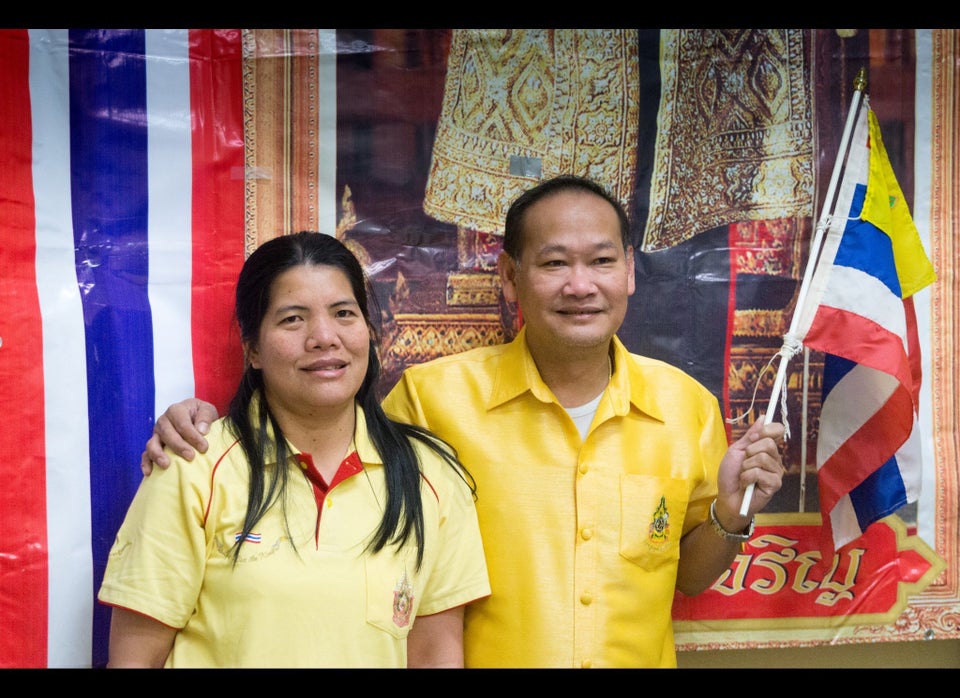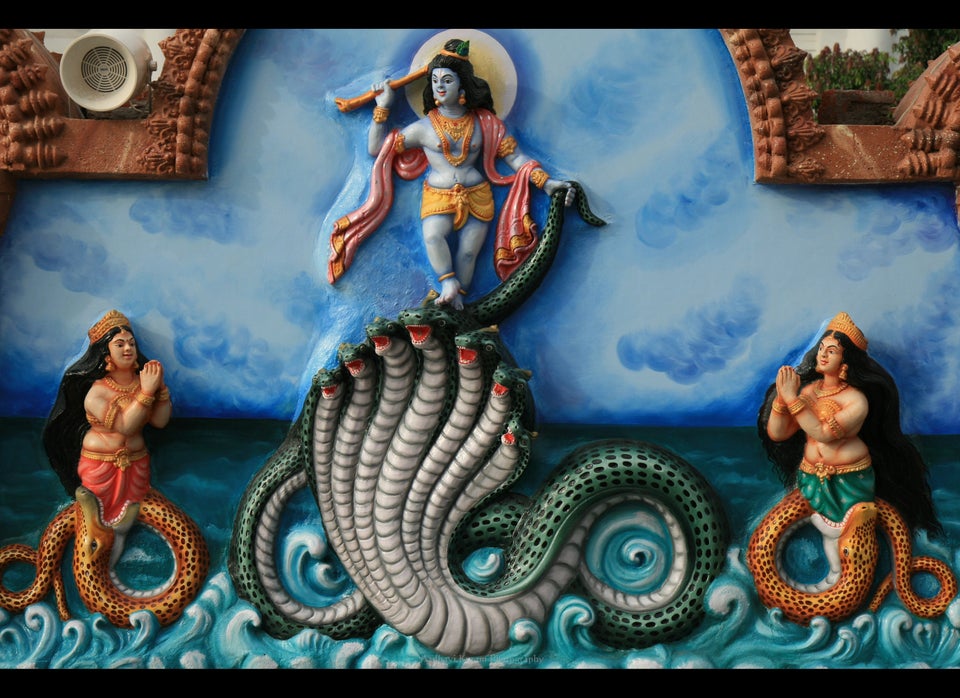Beautiful Garments From Around the World How Fashion Has Affected Different Countries
Colors play an important part in our lives. They can remind u.s. of a place, a fourth dimension of year, or our favorite traditions, and can besides shape the way we feel. But when it comes to what unlike colors symbolize in cultures effectually the world, these associations can vary greatly. Read on for a glimpse into how colors take shaped the history, emotions, and beliefs of different cultures through the ages.
(Photo: Thinkstock/iStock)

(Photo: Thinkstock/iStock)
Ruddy

Red is the near powerful of all colors in Indian civilisation and holds many important meanings. Among them are fearfulness and fire, wealth and ability, purity, fertility, seduction, love, and dazzler. Cherry is also representative of a certain time and place in i's personal life, including when a adult female gets married. A married woman can be identified by the red henna on her hands and the cherry-red powder, known equally sindoor, worn along her hairline.
In South Africa, red is associated with mourning, and the section of ruby-red in the country's flag symbolizes violence and sacrifices that were made during the struggle for independence.
In Thai tradition, each day of the week is assigned a specific color and is linked with a detail God. Cherry-red is the colour for Sundays, and information technology's associated with Surya, a solar God, who was built-in on this mean solar day. Many Thai people pay their respects to Surya by wearing red on his birthday each year.
In Chinese culture, ruby-red is traditionally worn on the New year's day, as well as during funerals and weddings. Information technology represents celebration and is meant to bring luck, prosperity, happiness, and a long life to the people.
RELATED:8 English language Words You Should Never Use Away
(Photo: Thinkstock/iStock)
Yellow

For a colour that makes many of united states experience cheery and warm, yellow has some surprisingly dark meanings in other cultures.
Have France, for example, where yellowish signifies jealously, betrayal, weakness, and contradiction. In the tenth century, the French painted the doors of traitors and criminals yellow. And in Deutschland, yellow symbolizes jealousy.
In China, yellowish is associated with pornography. When the Chinese term for "xanthous film" or "yellowish book" is used to talk over any type of publication or media, it'south in reference to pornographic images and websites.
Yellow is reserved simply to people of high rank in many African nations, because of its close resemblance to gilded, which is universally associated with money, quality, and success. Egyptians also closely associate yellow with gold, which was commonly used to pigment mummies and tombs earlier the deceased were sent to the afterlife, making information technology symbol for mourning.
In Japanese culture, xanthous has represented bravery, wealth, and refinement since the War of Dynasties in 1357. During this time, warriors wore yellow chrysanthemums—which represent the emperor in Nihon and imperial family—as a pledge of courage.
Considered lucky in Thai civilisation, yellowish is the lucky color for Mon, and it's considered the about important shade of the calendar week because it represents the King of Thailand, King Bhumibol, who has held reign since June 9, 1946, and was built-in on December 5th, in 1927—a Monday. To pay tribute to the rex, many Thais habiliment yellowish on Mondays, and some schools require all teachers to wear yellow during the first week of December.
(Photo: William Potato via flickr/CC Attribution)
Blue

From low to royalty to trust, bluish holds more meanings than any other color around the world.
In Western Cultures, blueish is usually associated with feeling melancholy—hence, having "the dejection." And while that'southward truthful, it'due south besides considered to be a calming and soothing color that symbolizes trust, security, and authority—a reason why many American banks, such as Citi and Bank of America, utilise bluish for their logo.
Blue is also a symbol of masculinity and represents the nativity of a boy—the opposite of Red china, where blue is considered a feminine colour.
In many Eye Eastern countries, blue means prophylactic and protection, and is symbolic of heaven, spirituality, and immortality.
Many religions have their own associations for the color blueish equally well. For example, in many Latin American countries—which are known to have high Catholic populations— blue is a sign of promise and good health, and is symbolic of Virgin Mary, who is often depicted wearing a blueish robe and headscarf, and represents wealth.
In Judaism, blue is the shade for holiness and divinity, and in Hinduism it's the color of Krishna—the most highly worshipped Hindu god who embodies love and joy, and destroys hurting and sin.
RELATED:5 Things You Should Never Say When Traveling
(Photo: Bindaas Madhavi via flickr/CC Attribution)
Dark-green

Green shares many common meanings effectually the world, some of which include nature, ecology, environmental awareness, the military, and the color for traffic lights.
In Western cultures, green represents spring, money, freshness, inexperience, jealously, greed, and Christmas (when combined with ruddy). Nicknamed The Emerald Isle for its luscious dark-green countryside, greenish is the national color in Republic of ireland and it'southward associated with skilful luck, leprechauns, shamrocks, and Saint Patrick.
Nearly Eastern and Asian cultures relate green with new and eternal life, new ancestry, fertility, youth, health, and prosperity. And while this is truthful in Chinese culture, wearing a green colored hat for men is taboo because it suggests the man's married woman is cheating on him.
Subsequently gaining its freedom from Spain in the 19th century, Mexico chose to display green in its flag to represent independence.
Across many Due south American cultures that are rich in forests, light-green symbolizes death.
(Photo: Thinkstock/iStock)
Purple

Royalty, wealth, power, exclusivity, and fame are common themes for the color imperial across many Eastern and Western cultures. For many centuries, purple dye was extremely rare and difficult to produce because information technology was extracted from ocean snails. As a upshot, purple clothing was expensive and became a status symbol amongst kings, queens, and other rulers.
Simply as black is the traditional color for death and grieving in many cultures, majestic shares the aforementioned pregnant in some European nations, including the U.K. and Italia, as well as Brazil, Thailand, India, and amid many Catholics. In Thailand and Brazil, purple is customarily worn alongside black when mourning of the death of a loved 1, and in Brazilian civilization, it is considered unlucky to wear purple when non attending a funeral or related service.
In the The states, majestic—the symbol for honor and courage—is represented by the Purple Centre, the military's highest award given to soldiers, sailors, Marines, and airmen for their acts of bravery.
RELATED:15 Crazy Potato Chip Flavors from Around the Earth
(Photo: Thinkstock/iStock)
Orangish

Ever heard that adding more than orange to your wardrobe will liven things up? That's because in many Western cultures, orange is considered a fun and edgy colour, and represents curiosity, trying new things, and inventiveness.
Sure countries also associate orange with wealth. In the Netherlands, for instance, it's the national color and represents the Dutch Imperial family unit. Merely in many Middle Eastern countries, such as Arab republic of egypt, orange is associated with mourning.
In Japanese and Chinese cultures, orange signifies courage, happiness, love, and good wellness. And in Indian cultures, it'due south symbolic of burn. The orange-colored spice, saffron, is considered to be lucky and sacred.
A symbol of strength and bravery in Ukraine, orange represents a time when the land came together in 2004 and stood up to the government during one of the biggest fraudulent presidential elections in history, known as the Orange Revolution.
(Photograph: Thinkstock/iStock)
Pink

It'south widely accepted in Western cultures equally the colour for femininity, love, romance, caring, tenderness, and the nativity of a baby girl. And while many Eastern countries associate pink with these meanings, they don't utilise to every culture.
In Japan, for instance, pink relates more to men than women, although it's worn by both genders. In Korea, it symbolizes trust, and in Latin America, it's symbolic to architecture. For many years, pink was an unrecognized colour in China until it emerged into the civilisation due to increasing Western influences—the Chinese word for it translates equally "foreign color."
And in general, pinkish is said to be mentally stimulating, reduce violent beliefs, and make people feel calmer and more controlled, which is why many prison house property cells are painted this colour.
(Photo: Thinkstock/iStock)
Read the original story: What Colors Mean in Other Cultures past Olivia Briggs, who is a regular correspondent to SmarterTravel.
More from SmarterTravel:
Besides on HuffPost:

0 Response to "Beautiful Garments From Around the World How Fashion Has Affected Different Countries"
Post a Comment